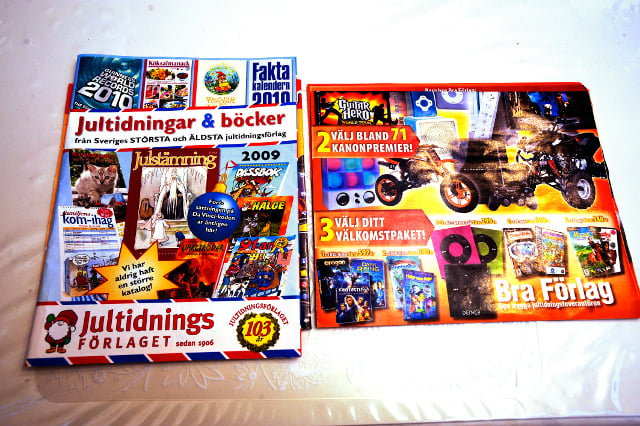#SwedishChristmas: The children selling magazines on your doorstep

Every day until Christmas Eve, The Local explains the unique history behind Swedish Christmas traditions in our own Advent calendar.
For more than a century, Swedish children have transformed for a few weeks each year into the travelling salespeople of Christmas spirit, and in the process have helped spread and popularize Swedish literature and art. Whether sold by knocking on neighbours' doors or by hitting up extended family members, Jultidningar (Christmas magazines) are a Swedish Christmas tradition with origins going back to the late 19th century and connections to many notable figures in Swedish history.
One of the earliest and most iconic Jultidningar was Jultomten, which was published between 1891 and 1934. The magazine played a key role in popularizing the now-classic image of the Jultomte, also known as the Swedish Santa, as illustrated by Swedish artists Jenny Nyström, Carl Larsson and others (more on that later this week). It also gave the children for whom it was published an introduction to the poetry and prose of some of Sweden's most respected writers, including at least two who later won the Nobel Prize in Literature.
One of these was Selma Lagerlöf, who in 1909 became the first woman awarded the honour. The 1891 issue of Jultomten included a chapter of Lagerlöf's then newly-published novel, Gösta Berling's Saga, which is today her most famous work. She went on to publish numerous stories in other popular Jultidningar, such as Julrosor (Christmas Rose) and Ungdomens Jul (Youth's Christmas). Lagerlöf's fellow Swedish Nobel laureate, Verner von Heidenstam, who won the prize in 1916, also contributed to Jultomten.

Today you can also order comics such as Donald Duck as your Christmas magazine. Photo: Ingvar Karmhed/SvD/TT
Further illustrating the high-calibre of content in the Jultidningar, many featured the wisdom of diverse notable Swedes. For instance, in the 1930s, an issue of Jul och Nyår (Christmas and New Year) featured reflections from religious leaders like Manfred Björkquist, Bishop of the Diocese of Stockholm between 1942 and 1954, and philosophers like Alf Ahlberg, whose body of work included criticisms of Nazism prior to World War II.
Not surprisingly, Jultidningar were extremely popular with both children and parents. At its height during the late 19th and early 20th century, Jultomten alone was selling around 200,000 copies each year. As a result, many new Jultidningar were introduced in the early 1900s. Some of these are still in print today, including Julstämning (Christmas Mood), which sold nearly 100,000 copies when it was introduced in 1906, and Smålänningens Jul (The Smålander's Christmas), first published in 1925.
Comments
See Also
For more than a century, Swedish children have transformed for a few weeks each year into the travelling salespeople of Christmas spirit, and in the process have helped spread and popularize Swedish literature and art. Whether sold by knocking on neighbours' doors or by hitting up extended family members, Jultidningar (Christmas magazines) are a Swedish Christmas tradition with origins going back to the late 19th century and connections to many notable figures in Swedish history.
One of the earliest and most iconic Jultidningar was Jultomten, which was published between 1891 and 1934. The magazine played a key role in popularizing the now-classic image of the Jultomte, also known as the Swedish Santa, as illustrated by Swedish artists Jenny Nyström, Carl Larsson and others (more on that later this week). It also gave the children for whom it was published an introduction to the poetry and prose of some of Sweden's most respected writers, including at least two who later won the Nobel Prize in Literature.
One of these was Selma Lagerlöf, who in 1909 became the first woman awarded the honour. The 1891 issue of Jultomten included a chapter of Lagerlöf's then newly-published novel, Gösta Berling's Saga, which is today her most famous work. She went on to publish numerous stories in other popular Jultidningar, such as Julrosor (Christmas Rose) and Ungdomens Jul (Youth's Christmas). Lagerlöf's fellow Swedish Nobel laureate, Verner von Heidenstam, who won the prize in 1916, also contributed to Jultomten.

Today you can also order comics such as Donald Duck as your Christmas magazine. Photo: Ingvar Karmhed/SvD/TT
Further illustrating the high-calibre of content in the Jultidningar, many featured the wisdom of diverse notable Swedes. For instance, in the 1930s, an issue of Jul och Nyår (Christmas and New Year) featured reflections from religious leaders like Manfred Björkquist, Bishop of the Diocese of Stockholm between 1942 and 1954, and philosophers like Alf Ahlberg, whose body of work included criticisms of Nazism prior to World War II.
Not surprisingly, Jultidningar were extremely popular with both children and parents. At its height during the late 19th and early 20th century, Jultomten alone was selling around 200,000 copies each year. As a result, many new Jultidningar were introduced in the early 1900s. Some of these are still in print today, including Julstämning (Christmas Mood), which sold nearly 100,000 copies when it was introduced in 1906, and Smålänningens Jul (The Smålander's Christmas), first published in 1925.
Join the conversation in our comments section below. Share your own views and experience and if you have a question or suggestion for our journalists then email us at [email protected].
Please keep comments civil, constructive and on topic – and make sure to read our terms of use before getting involved.
Please log in here to leave a comment.